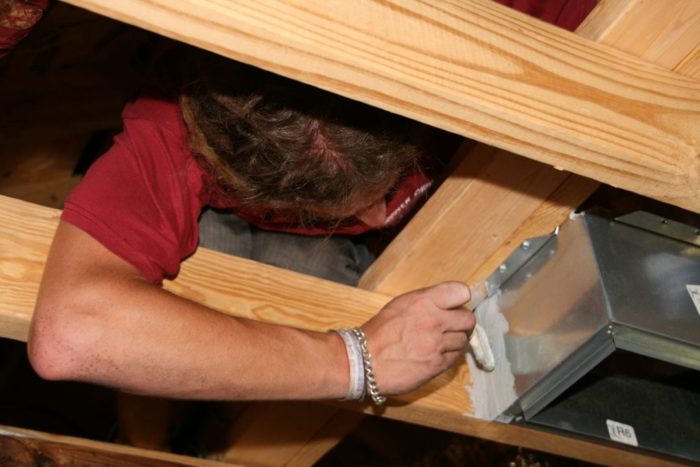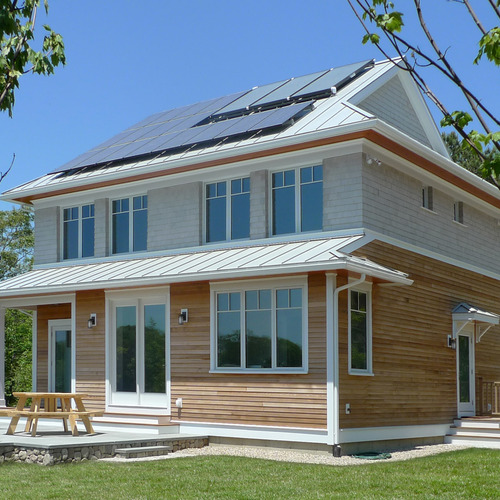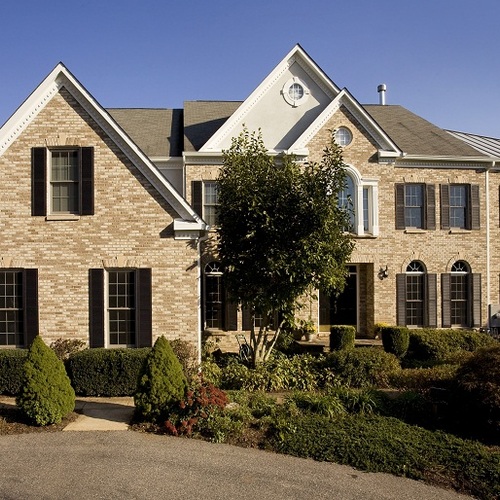
Image Credit: Rob Moody, Organic Think Inc
Musings on Mazria, Lstiburek and Gifford: Part Five
Am I beating a dead horse with this subtitle? I’ll make this the last entry in the series and move on. This post will be the cathartic culmination of my scattered thought process throughout. At the Southface Greenprints Conference in Atlanta last month, I was privileged to see Ed Mazria speak about Architecture 2030 as it relates to current economic and environmental upheaval. He spent some time talking about and visualizing the effects of global climate change and sea level rise on familiar coastal cities in the United States. He shared the summative conclusion of his 2003 article, “It’s the Architecture, Stupid!”, in which he states that architects hold the lion’s share of the responsibility when it comes to sustainable building practices because they situate, design, and spec the majority of commercial built space in the world.
He then dove into a hypothetical example of his proposal to right the US economy, at least partially. In the example, a fictional homeowner, let’s call him Frank, seeks to improve the energy efficiency of his home by 75%. To achieve this, he needs to refinance. Mazria proposes that Frank be approved to refinance and, because he is significantly improving the efficiency of his home, that the federal government utilizes stimulus funds to “buy down” his interest rate:
| Mortgage Interest Rate* (Energy Savings) |
2030 Challenge Energy Reduction |
|---|---|
| 4.0% | 30% below code |
| 3.5% | 50% below code |
| 2.5% | 75% below code |
| 2.0% | Carbon neutral |
For example, a homeowner carrying a current mortgage of $272,300 with equity of $12,000 would have a mortgage balance of $260,300. At 6% interest, the monthly mortgage payment would be $1633. If this homeowner wants to qualify for the 2.5% interest rate, he will need to renovate his home to use 75% less energy than that required by code, immediately creating jobs and putting construction teams back to work.
The cost of renovation would be approximately $51,250, which includes a solar system. The solar system would qualify for a $7,000 tax credit. The cost of the renovation, minus the tax credit, would be added to the mortgage balance, bringing the new mortgage to $304,550. However, because of the significantly lower interest rate, i.e. 2.5%, the new mortgage payment is now $1203, a savings of $430 per month. With the additional monthly savings on energy bills of approximately $145, this homeowner would save a total of $575 per month.
Making a significant investment in energy efficiency in Frank’s home results in lower energy bills. Combine that with the reduced rate, and most folks would come out of the refinancing with a net positive monthly cash flow. Sounds great!
This would immediately create jobs and get people spending, or at least saving again. Mazria goes on to explain that the proposal could create 9 million jobs and $1 trillion in private spending in the next two years and pay for itself every year by the increased tax base.
You can read more about this in “The Architecture 2030 Challenge Stimulus Plan.”
During the question-and-answer session after Mazria’s speech, a builder in the audience asked where the experienced and knowledgeable trades were to be found to perform this plethora of work. He stated that he had trouble finding people who were qualified to do traditional work well, let alone green work. There is no doubt in my mind that there are very knowledgeable builders and trades out there; many in my area have done incredible green work on my homes. However, an effort of this size and scope will need more green leadership than currently exists. Mazria responded by saying that the majority of the current building workforce is itching to get work, and they will jump at the chance to do any work, green or otherwise. While this is true, it doesn’t get to the heart of the issue.
If stimulus money is spent on green upfit, and the upfit doesn’t perform in a green manner, then we have lost this battle. The bad press will spread like wildfire. “’Green Building’ is Bunk, Studies Show.” “’Energy Efficiency Doesn’t Work!’” and on and on. Of course, the truth is that it does work, but the media outlets are broken. In 2009, perception is reality, so if the news says it, it is rote.
So how do we avoid this impending doom? Training, my friends. I love Mazria’s proposal, but it absolutely must be accompanied by a massive training effort for the entire building industry. Real training about real green building. The “green bling” (solar photovoltaic, green roofs, bamboo) can be great, but this initiative needs to focus on the less glamorous practices of proper insulation technique, air sealing, proper ventilation, window installation, flashing, water heating efficiency. To me, these things are both glamorous and sexy. Crawl-space sealing should be considered HOT! Only after these bases are totally covered should we start to spend time on the “poster children” of the green movement. We are at the beginning of the whirlwind of change, and we must keep the momentum going.
Here’s a summary of what I have rambled about over the last five posts:
-
1. “Can’t We All Just Get Along?” Let’s put aside our differences in the green-building industry and use our collective knowledge to improve existing programs so that we don’t waste time reinventing the wheel.
-
2. “I Had a Horrible Stats Professor…” All of the players seem to have the same goal: to build better buildings. If we get lost in the trees, we won’t see the forest.
-
3. “…Lessons in Hot Air and Sticks and Stones” are distracting, and the devil is in the details. Save the insults and catch flies with honey. Lots of the more complex strategies in green building can be properly implemented if the installers know why they are doing it.
-
4. “The Dogma Syndrome!” We have to trust that both the workforce and homeowners can understand the concepts behind why green building works. Telling someone “how” is not the same as telling them “why.” Teach them to fish.
-
5. And finally, “It’s the Training, Really Competent, Capable, Nice People!” Money is going to be spent on energy efficiency and green-building products and practices. It is inevitable that some of this money will be misspent, but there must be a huge training component accompanying every “green” dollar that goes out in the stimulus that must be implemented in every town receiving funding.
Let me know what you think in the comments below: HOW CAN EFFECTIVE GREEN TRAINING BE IMPLEMENTED ACROSS THE COUNTRY?
Weekly Newsletter
Get building science and energy efficiency advice, plus special offers, in your inbox.











7 Comments
Last 5 Posts
Rob,
I've enjoyed following your "series" of posts, but I am unable to locate your 4th post, "The Dogma Syndrome!" through the search function of this site. Can you point me in the right direction?
Thanks,
Grant
Thanks!
Thanks for the comment. I will look into the whereabouts of the missing blog and get back to you.
"Where was the blog when you last saw it?"
"If I knew the answer to that question, i would know where the blog was!"
Someone didn't click 'publish'
I clicked it, the article is up now.
Thanks
Lieutenant Dan!
One place to start is in the
One place to start is in the education of our youth. Public and private schools from kindergarten on through should incorporate sustainable education. As students progress through the years, those that direct themselves to the fields of design, engineering or the technical trades will have a solid background in sustainable living practices and strategies. The students that direct themselves to other fields will also have an inate sustainable life philosophy to guide them. The work force is another problem. Trade unions should have training and education for their membership from the apprentice level on up to the journeyman. Somehow incentives should be provided to the independent contractor or individual to promote education in sustainable, integrated design and constuction. If we are going to make these ideals a reality for everyone this is a must. Promoting sustainable education in the work force results in strength to carry on the task of protecting our environment, combating climate change and global warming, and preserving a healthy planet for the future generations of all living species. We are in this together, and together we can succeed.
Great post
really enjoyed the reading. May I suggest you guys insert some links to previous posts in multi-post articles?
Here are the links
Marc,
Here are the links you requested:
# 1. "Can’t We All Just Get Along?"
https://www.greenbuildingadvisor.com/blogs/dept/business-advisor/cant-we-all-just-get-along
# 2. "I Had a Horrible Stats Professor..."
https://www.greenbuildingadvisor.com/blogs/dept/business-advisor/i-had-horrible-stats-professor-still-learned-basics
# 3. "...Lessons in Hot Air and Sticks and Stones"
https://www.greenbuildingadvisor.com/blogs/dept/business-advisor/build-tight-ventilate-right-lessons-hot-air-and-sticks-and-stones
# 4. "The Dogma Syndrome!"
https://www.greenbuildingadvisor.com/blogs/dept/business-advisor/dogma-syndrome
Log in or create an account to post a comment.
Sign up Log in